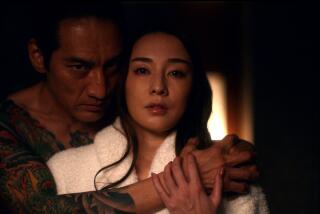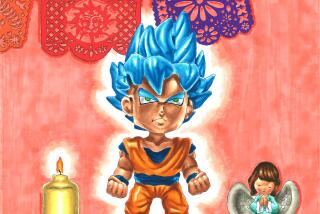‘Zatoichi’ wields blades with kabuki precision
- Share via
“The Blind Swordsman: Zatoichi,” the latest entertainment from Japanese filmmaker Takeshi Kitano, isn’t your average blind masseur-gambler-swordsman movie. Based on a series of popular genre standards, the film stars the multitalented auteur as an avenger who wanders the 19th century countryside in a platinum blond buzz cut while swinging the kind of lethal cane favored by William S. Burroughs. When he’s not down at the local gambling parlor or untying the knots in some farmer’s scapulae, Zatoichi can be found carving Zs in the backs of miscreants. Not surprisingly, his Zorro-like deep-tissue work tends to prove fatal.
This is the first period story from Kitano, best known for his sensational genre-bending features such as the yakuza film “Sonatine” and the cop melodrama “Hana-Bi.” Beginning in the early 1960s, the venerated Japanese film studio Daiei produced more than two dozen films about the adventures of the blind masseur-swordsman, one even featuring Toshiro Mifune. Kitano has said in interviews that the idea for a new Zatoichi originated with a friend of Shintaro Katsu, the series’ star and sometime director. Along with the hair and cane, Kitano amended the character’s vibe. “Mr. Katsu’s Zatoichi,” he explained, “was more about almost heart-warming relationships he made with the good and meek townspeople. Mine doesn’t fully mingle with the good guys. He just keeps slaying bad guys!”
And, after a few uncharacteristic moments of calm, that’s precisely what Zatoichi does. The film opens with the camera fixed on the character, his eyes closed and seated in a state of apparent repose. Suddenly, a gang of samurai struts into view. One of the samurai instructs a young and conveniently situated passerby to steal the blind man’s cane, which the kid does without a hitch. Satisfied that their prey has been disarmed, the samurai descend on the blind man. In a series of moves so fast they’re almost impossible to see (a classic bit of Kitano waggery), Zatoichi swiftly vanquishes the samurai. Through a fusillade of grunts and flashes of clanging steel, the samurai fall in slowed motion, their blood either fanning across the air or pebbling it like beads from a broken necklace.
Kitano’s aesthetic of violence has few parallels in contemporary cinema. Although it differs from film to film, the violence generally feels as if it comes out of nowhere, even in the midst of a gun battle. The shock of these sudden eruptions keeps you nervously off balance, because you’re never sure when the next bullet or blow will come, or from where. (In “Hana-Bi,” Kitano’s character stops eating to plunge a chopstick into another man’s eye.) The abruptness of the violence and its occasionally discomforting comic undertow means that when characters die in a Kitano film (which they often do), they don’t die according to some proscribed genre formulation or spurious moral code. Good guys kill in his films just like bad guys do, and whether they’re good or bad makes no difference to their victims.
In “Zatoichi,” the bad and the good fall indiscriminately as the masseur-swordsman takes the side of local peasants who are, in classic dramatic fashion, being squeezed by the neighborhood thugs. There’s nothing noble about the swordsman’s action, however, no sense that he’s following the warrior’s code. Rather, whether he’s mowing down a roomful of gamblers or sniffing out trouble (“You don’t smell like a woman,” he tells a blade-wielding cross-dresser), there’s a sense that he is following his own code, his own way. For a filmmaker whose genre films continually push against the limits of genre form, such a contrary, non-classical approach to this otherwise classic story makes total sense. What makes Kitano’s approach in this film all the more unusual is that he has incorporated a number of elements from traditional Kabuki theater into his storytelling.
There has always been more than a touch of Kabuki in Kitano’s stories and his on-camera performance style, which veers between stone-like stillness and bursts of comedy or violent action. (His last film, “Dolls,” was inspired by the work of one of the greatest Kabuki playwrights.) The Kabuki effect is even more pronounced in “Zatoichi.” Kabuki has its origin in dance, and music and dance remain essential to the theatrical form, even in non-dance dramas; the highly stylized performances are generally accompanied by music and are as meticulously choreographed as any Balanchine ballet. In “Zatoichi,” Kitano uses exaggerated acting, choreo- graphed violence and, most radically, the rhythms of everyday life -- farmers pounding the earth, the syncopated plop of falling rain -- to turn this genre story into a crypto-Kabuki play and one blissfully idiosyncratic diversion.
“Zatoichi” starts out fairly far-out and, happily, only gets weirder. Threaded between the swordsman’s adventures inside gambling dens and out are the story of a ronin and his tubercular wife, and the equally sad tale of an orphaned brother and sister out for revenge. Each of these characters takes up considerable time and space and has a relatively lengthy flashback scene that doesn’t so much advance the film as enrich it. That’s of a piece with a filmmaker whose work is filled with putatively useless stylistic flourishes, oddball characters and digressions. Toward the end of “Zatoichi,” there’s a scene of such unexpected wildness and joy that it can only be seen to be believed. Kitano’s character may have his eyes closed, but this is one filmmaker who always ensures that the audience has theirs wide open.
*
‘The Blind Swordsman: Zatoichi’
MPAA rating: R for stong stylized bloody violence
Times guidelines: Bloody sword fights; adult themes, including sexuality.
“Beat” Takeshi Kitano...Zatoichi
Tadanobu Asano...Gennosuke Hattori
Yui Natsukawa...O-Shino (Hattori’s wife)
Michiyo Ookusu...Aunt O-Ume
Gadarukanaru Taka...Shinkichi (the gambler)
A production of Bandai Visual, Tokyo FM, Dentsu, TV Asahi, Saito Entertainment and Office Kitano, released by Miramax Films. Writer-director-editor Takeshi Kitano. Based on a short story by Kan Shimozawa. Producers Masayuki Mori, Tsunehisa Saito. Music Keiichi Suzuki. Tap dance choreography the Stripes. Costume supervisor Yohji Yamamoto. Costume design Kazuko Kurosawa. Cinematography Katsumi Yanagijima. Lighting design Hitoshi Takaya. Production design Norihiro Isoda. Sound design Senji Horiuchi. In Japanese with English subtitles. Running time: 1 hour, 55 minutes.
Exclusively at the ArcLight, 6360 W. Sunset Blvd., Hollywood, (323) 464-4226.
More to Read
Only good movies
Get the Indie Focus newsletter, Mark Olsen's weekly guide to the world of cinema.
You may occasionally receive promotional content from the Los Angeles Times.










